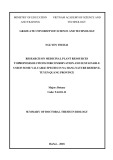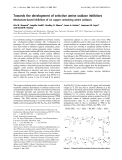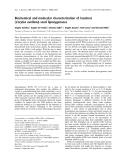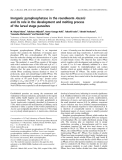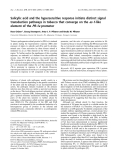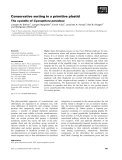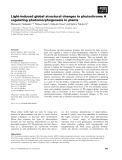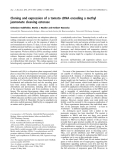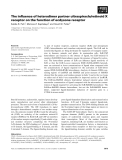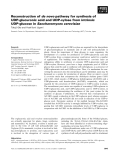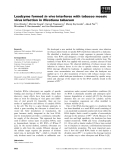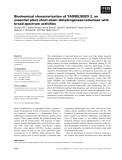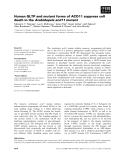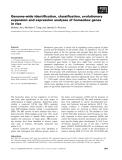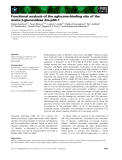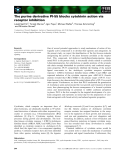
Development of medicinal plants
-
The meaning of the dissertation topic: This research contributes to complete the list and evaluate the diversity of medicinal plants in the coastal districts of Thai Binh province to serve local medical needs.
 30p
30p  capheviahe27
capheviahe27
 23-02-2021
23-02-2021
 33
33
 3
3
 Download
Download
-
The main aim of this thesis is to overcome the second limitation of the automatic plant identification (low recognition accuracy) by proposing novel and robust methods for plant recognition. For this, we first focus on improving the recognition accuracy of plant identification based on images of one sole organ. Among different organs of the plant, we select leaf as this organ is the most widely in the literature.
 27p
27p  gaocaolon6
gaocaolon6
 30-07-2020
30-07-2020
 30
30
 3
3
 Download
Download
-
The thesis is based on the criteria of the analytical framework for development of medicinal plants towards sustainability; limitations of the status of development of medicinal plants; Based on the direction of development of medicinal plants, it gives points of view and orientations for development of medicinal plants in Lao Cai province.
 0p
0p  dungmaithuy
dungmaithuy
 17-09-2019
17-09-2019
 45
45
 3
3
 Download
Download
-
The goal of the dissertation: To study and evaluate the current status of medicinal plant resources in Na Hang Nature Reserve, Tuyen Quang provinceto propose solutions for conservation and sustainable development of some valuable species
 27p
27p  xacxuoc4321
xacxuoc4321
 11-07-2019
11-07-2019
 46
46
 5
5
 Download
Download
-
Agrobacterium tumefaciens is a Gram-negative, phytopathogenic bacterium and is characterized by an unique mode of action on dicotyledonous plants: it is able to genetically modify the host, and because of this feature, it is used as a tool for transgenic plants. Many experiments have demonstrated that lipopolysaccharides (LPSs) play an important role for the disease development, as they are involved in the adhesion process of the bacterium on the plant cell wall.
 4p
4p  system191
system191
 01-06-2013
01-06-2013
 32
32
 4
4
 Download
Download
-
Four substrate analogs, 4-(2-naphthyloxy)-2-butyn-1-amine (1), 1,4-diamino-2-chloro-2-butene (2), 1,6-diamino-2,4hexadiyne (3), and 2-chloro-5-phthalimidopentylamine (4) have been tested as inhibitors against mammalian, plant, bacterial, and fungal copper-containing amine oxidases: bovine plasma amine oxidase (BPAO), equine plasma amine oxidase (EPAO), pea seedling amine oxidase (PSAO), Arthrobacter globiformis amine oxidase (AGAO), Escherichia coli amine oxidase (ECAO), and Pichia pastoris lysyl oxidase (PPLO).
 14p
14p  research12
research12
 01-06-2013
01-06-2013
 43
43
 6
6
 Download
Download
-
Plant lipoxygenases (LOXs) are a class of dioxygenases which display diverse functions in several physiological processes such as growth, development and response to biotic and abiotic stresses.Even though LOXs have been characterized from several plant species, the physiological role of seed LOXs is still unclear.With the aim to better clarify the occurrence of LOXs and their influence on hazelnut seed quality, we carried out the biochemical and molecular characterization of the main LOX isoforms expressed during seed development....
 11p
11p  tumor12
tumor12
 20-04-2013
20-04-2013
 34
34
 4
4
 Download
Download
-
Inorganic pyrophosphatase (PPase) is an important enzyme that catalyzes the hydrolysis of inorganic pyro-phosphate (PPi)intoortho-phosphate (P i ). We report here the molecular cloning and characterization of a gene encoding the soluble PPase of the roundworm Ascaris suum. The predicted A. suumPPase consists of 360 amino acids with a molecular mass of 40.6 kDa and a pI of 7.1.
 13p
13p  fptmusic
fptmusic
 16-04-2013
16-04-2013
 35
35
 3
3
 Download
Download
-
Tobacco pathogenesis-related protein 1a (PR-1a) is induced in plants during the hypersensitive response (HR) after exposure of plants to salicylic acid (SA) and by develop-mental cues.Gene activation by these diverse stimuli is mediated via anas-1-like element in the PR-1aupstream region.To further analyze the significance of thiscis-acting sequence, an authentic as-1element from the cauliflower mosaic virus 35S RNA promoter was inserted into the PR-1apromoter in place of theas-1-like motif.
 11p
11p  fptmusic
fptmusic
 12-04-2013
12-04-2013
 37
37
 3
3
 Download
Download
-
Higher plant chloroplasts possess at least four different pathways for pro-tein translocation across and protein integration into the thylakoid mem-branes. It is of interest with respect to plastid evolution, which pathways have been retained as a relic from the cyanobacterial ancestor (‘conserva-tive sorting’), which ones have been kept but modified, and which ones were developed at the organelle stage, i.e. are eukaryotic achievements as (largely) the Toc and Tic translocons for envelope import of cytosolic pre-cursor proteins. ...
 12p
12p  awards
awards
 05-04-2013
05-04-2013
 36
36
 4
4
 Download
Download
-
Phytochromes are photoreceptor proteins that monitor the light environ-ment and regulate a variety of photomorphogenic responses to optimize the growth and development of plants. Phytochromes comprise N-terminal photosensory and C-terminal regulatory domains. They are mutually pho-toconvertible between a red-light-absorbing (Pr) and a far-red-light-absorb-ing (Pfr) form. Their interconversion by light stimuli initiates downstream signaling cascades.
 10p
10p  awards
awards
 05-04-2013
05-04-2013
 46
46
 4
4
 Download
Download
-
Jasmonic acid and its methyl ester are ubiquitous plant sig-nalling compounds necessary for the regulation of growth and development, as well as for the response of plants to environmental stress factors. To date, it is not clear whether methyl jasmonate itself acts as a signal or if its conversion to jasmonic acid is mandatory prior to the induction of a def-ense response. We have cloned a cDNA, encoding a methyl jasmonate-cleaving enzyme, from tomato cell suspension cultures.
 8p
8p  awards
awards
 05-04-2013
05-04-2013
 54
54
 5
5
 Download
Download
-
A pair of nuclear receptors, ecdysone receptor (EcR) and ultraspiracle (USP), heterodimerize and transduce ecdysteroid signals. The EcR and its nonsteroidal ligands are being developed for regulation of transgene expres-sion in humans, animals and plants. In mammalian cells, EcR:USP heterodimers can function in the absence of ligand, but EcR⁄retinoid X receptor (EcR:RXR) heterodimers require the presence of ligand for activa-tion.
 12p
12p  dell39
dell39
 27-03-2013
27-03-2013
 43
43
 4
4
 Download
Download
-
UDP-d-glucuronic acid and UDP-d-xylose are required for the biosynthesis of glycosaminoglycan in mammals and of cell wall polysaccharides in plants. Given the importance of these glycans to some organisms, the development of a system for production of UDP-d-glucuronic acid and UDP-d-xylose from a common precursor could prove useful for a number of applications.
 13p
13p  inspiron33
inspiron33
 26-03-2013
26-03-2013
 68
68
 5
5
 Download
Download
-
We developed a new method for inhibiting tobacco mosaic virus infection in tobacco plants based on specific RNA hydrolysis induced by a leadzyme. We identified a leadzyme substrate target sequence in genomic tobacco mosaic virus RNA and designed a 16-mer oligoribonucleotide capable of forming a specific leadzyme motif with a five-nucleotide catalytic loop.
 10p
10p  inspiron33
inspiron33
 23-03-2013
23-03-2013
 38
38
 2
2
 Download
Download
-
The development of unisexual flowers in maize and other plants proceeds through selective elimination of floral organs in an initially bisexual floral meristem. The essential character of thetasselseed 2 gene (TS2) in this cell-death pathway has been established previously.
 11p
11p  galaxyss3
galaxyss3
 21-03-2013
21-03-2013
 22
22
 3
3
 Download
Download
-
TheArabidopsis acd11mutant exhibits runaway, programmed cell death due to the loss of a putative sphingosine transfer protein (ACD11) with homology to mammalian GLTP. We demonstrate that transgenic expres-sion in Arabidopsis thalianaof human GLTP partially suppressed the phenotype of theacd11null mutant, resulting in delayed programmed cell death development and plant survival.
 11p
11p  galaxyss3
galaxyss3
 07-03-2013
07-03-2013
 48
48
 4
4
 Download
Download
-
Homeobox genes play a critical role in regulating various aspects of plant growth and development. In the present study, we identified a total of 107 homeobox genes in the rice genome and grouped them into ten distinct subfamilies based upon their domain composition and phylogenetic analy-sis.
 17p
17p  media19
media19
 06-03-2013
06-03-2013
 48
48
 3
3
 Download
Download
-
b-Glucosidases such as Zm-p60.1 (Zea mays) and Bgl4:1 (Brassica napus) have implicated roles in regulating plant development by releasing biologi-cally active cytokinins from O-glucosides. A key determinant of substrate specificity in Zm-p60.1 is the F193–F200–W373–F461 cluster. However, despite sharing the same substrates, amino acids in the active sites of Zm-p60.1 and Bgl4:1 differ dramatically.
 13p
13p  vinaphone15
vinaphone15
 28-02-2013
28-02-2013
 45
45
 3
3
 Download
Download
-
One of several potential approaches to study mechanisms of action of bio-logically active compounds is to develop their agonists and antagonists. In the present study, we report the identification of the first known molecule antagonizing the activity of the plant hormone cytokinin at the receptor level.
 10p
10p  vinaphone15
vinaphone15
 27-02-2013
27-02-2013
 34
34
 2
2
 Download
Download
CHỦ ĐỀ BẠN MUỐN TÌM












